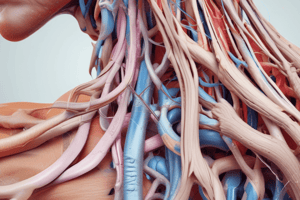Podcast
Questions and Answers
What do Deep Tendon Reflexes (DTR) elicit?
What do Deep Tendon Reflexes (DTR) elicit?
- Muscle relaxation
- Muscle contraction (correct)
- Pain response
- Fatigue
DTR provides a motor response to a sensory _____ used for assessment.
DTR provides a motor response to a sensory _____ used for assessment.
stimulation
What is the first guideline for the DTR procedure?
What is the first guideline for the DTR procedure?
Patient should be relaxed
How many sides of the body should be assessed during the DTR procedure?
How many sides of the body should be assessed during the DTR procedure?
How can reflexes be graded during a DTR assessment?
How can reflexes be graded during a DTR assessment?
Match the DTR grading with its corresponding response:
Match the DTR grading with its corresponding response:
What is the normal response for the biceps tendon?
What is the normal response for the biceps tendon?
What does the patellar tendon DTR assess?
What does the patellar tendon DTR assess?
Flashcards are hidden until you start studying
Study Notes
Deep Tendon Reflexes (DTR)
- Elicit muscle contraction upon tendon stimulation, serving as a motor response to sensory input.
- Assess the integrity of the nervous system through reflex actions.
DTR Procedure Guidelines
- Ensure the patient is relaxed for accurate results.
- Position the muscle in a slight stretch to facilitate reflex testing.
- Utilize a reflex hammer to tap the tendon and expect an immediate response.
- Assess reflexes on both sides of the body for comparison.
- Reflexes are graded on a scale from 0 to 4: normal, exaggerated (hyper), or depressed (hypo).
DTR Grading Scale
- 0: No response observed.
- 1+: Diminished or depressed reflex response.
- 2+: Active, normal reflex response.
- 3+: Brisk or exaggerated reflex response.
- 4+: Very brisk or hyperactive reflex, indicating abnormal response.
Common DTR Sites - Normal Response: 1
- Biceps tendon: Results in contraction of the biceps muscle.
- Brachioradialis tendon: Produces elbow flexion and/or forearm pronation.
- Triceps tendon: Leads to elbow extension or contraction of the triceps muscle.
Common DTR Sites - Normal Response: 2
- Patellar tendon: Triggers knee extension.
- Tibialis Posterior tendon: Causes plantar flexion and inversion of the foot.
- Achilles tendon: Stimulates plantar flexion of the foot.
Studying That Suits You
Use AI to generate personalized quizzes and flashcards to suit your learning preferences.



